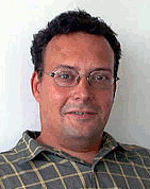 |
|
Biography
Johann Cervenka was born in Schwarzach, Austria, in 1968. He studied electrical engineering at the Technische Universität Wien, where he received the degree of Diplomingenieur in 1999. He then joined the Institute for Microelectronics at the Technische Universität Wien and received his PhD degree in 2004. His scientific interests include three-dimensional mesh generation, as well as algorithms and data structures in computational geometry.
A Deterministic Approach for the Wigner Equation
The development of novel nanoelectronic devices requires methods capable of simulating quantum mechanical effects in the carrier transport processes. The Wigner formalism is convenient to simulate electronic devices by describing quantum mechanics in the phase space. The integral formulation avoids the discretization of the diffusion term in the Wigner equation, which presents difficulties due to the rapid variations of the Wigner function in the phase-space. A deterministic approach to solving the integral formulation of the Wigner equation was developed.
This method considers the evolution of an initial condition as the superposition of the propagation of particular fundamental contributions. At each desired time step, all solutions of the Wigner equations of all evolving wave-packets have to be accumulated.
Major considerations are necessary to overcome the memory and time demands typical for any quantum transport method.
Unfortunately, the usual approach to solve at sequential time-steps is not practical due to the huge memory consumption: during the time evolution the complete history of all fundamental solutions in phase-space has to be stored in parallel. To overcome this drawback, the calculation order is modified in such a way that for each solution the specific time evolution is calculated separately.
An advantage of our method is that it is perfectly suited for parallelization due to the independence of each fundamental contribution. Additionally, with preconditioning of the resulting equation system a dramatic speed-up in simulation times is achieved.
To evaluate this deterministic approach, the simulation of a Resonant Tunneling Diode will be shown. A wave packet enters the biased device and is partially reflected by two potential barriers. Depending on the bias, a resonance behavior can be observed which cannot be explained classically. In the Fig. 1, the resulting wavepackages are shown after some time in dependency of the bias voltage as they pass the barriers.

Fig. 1: Evolution of a wave packet passing a double barrier after 200fs in dependency of the bias voltage.



